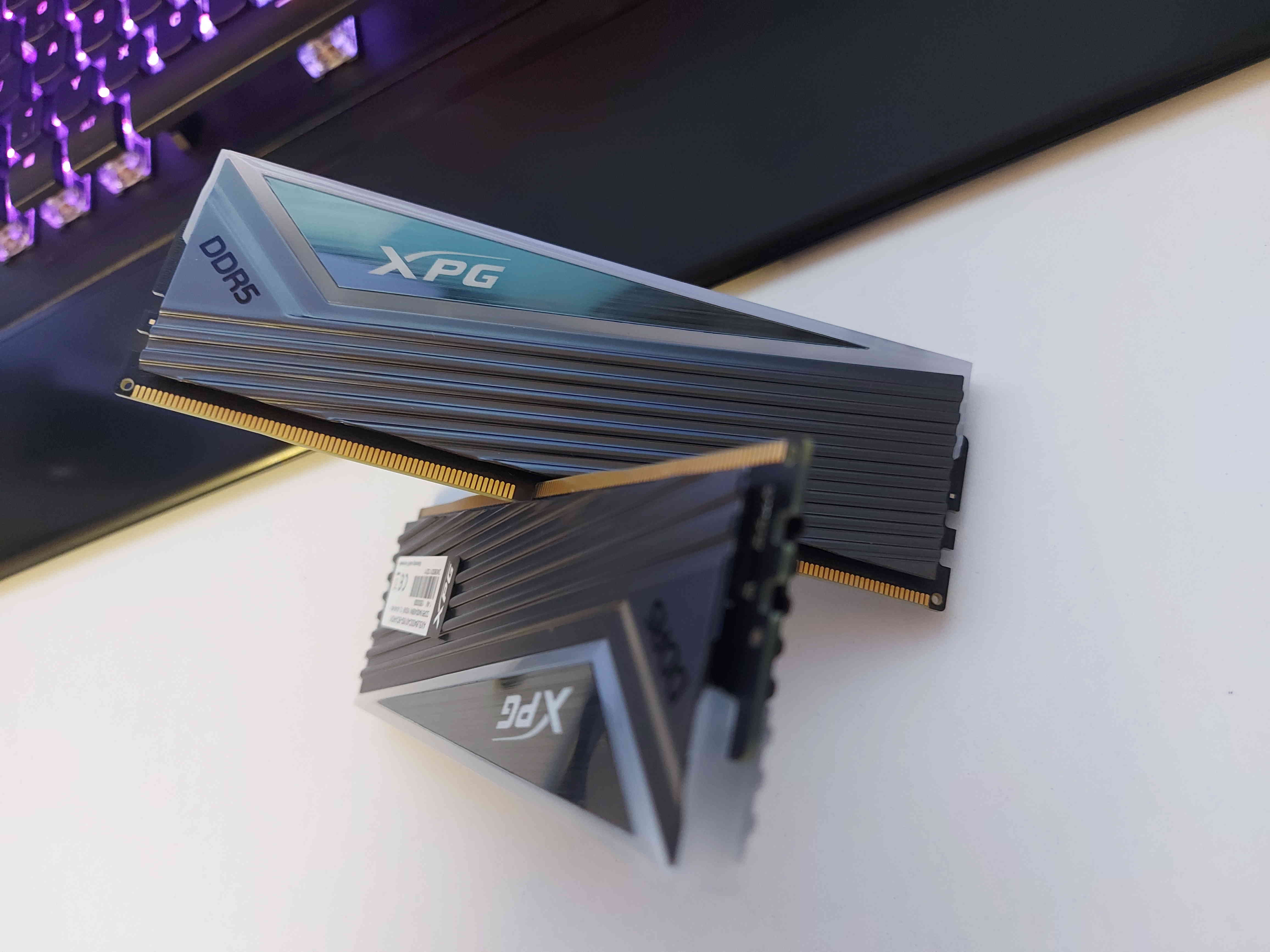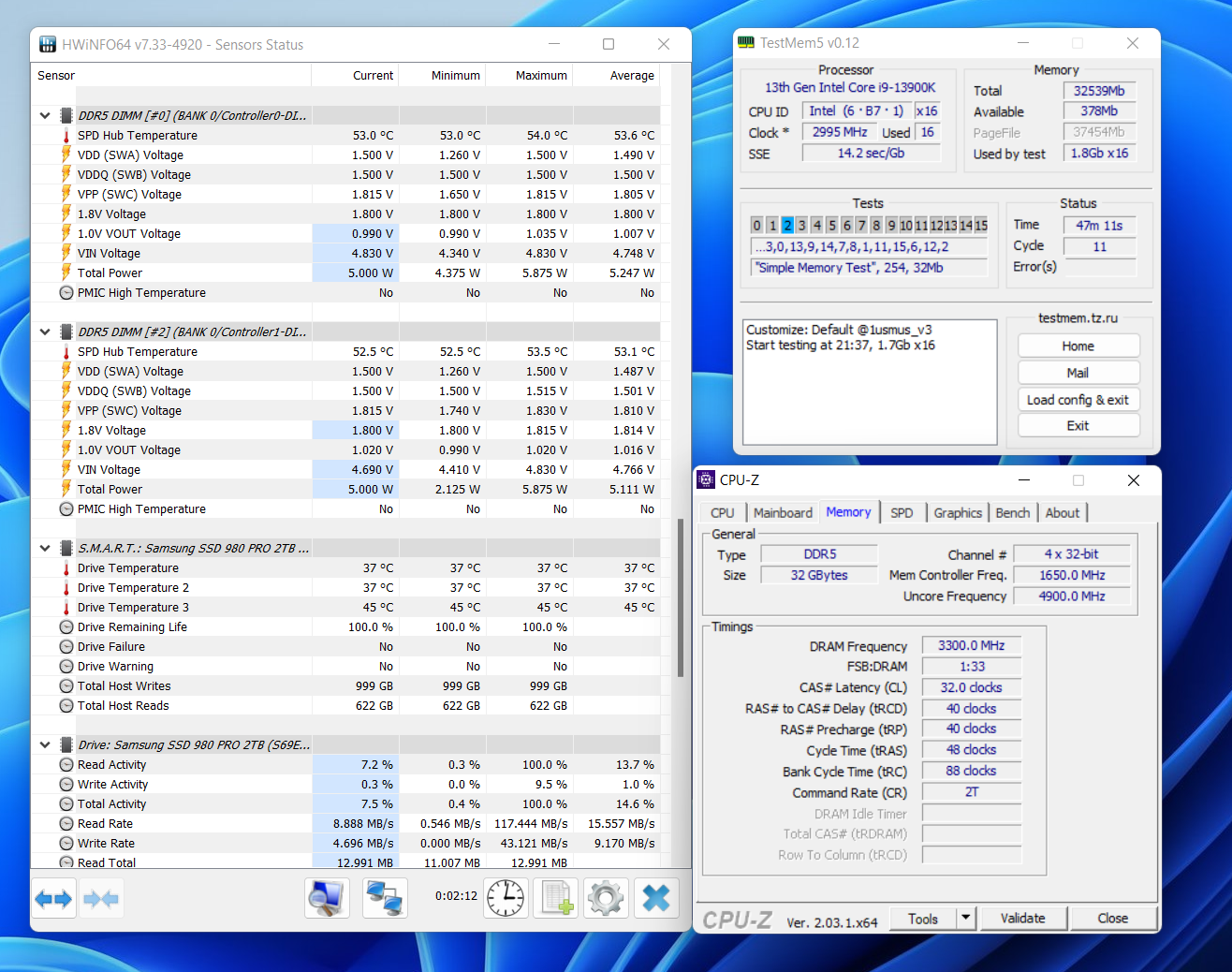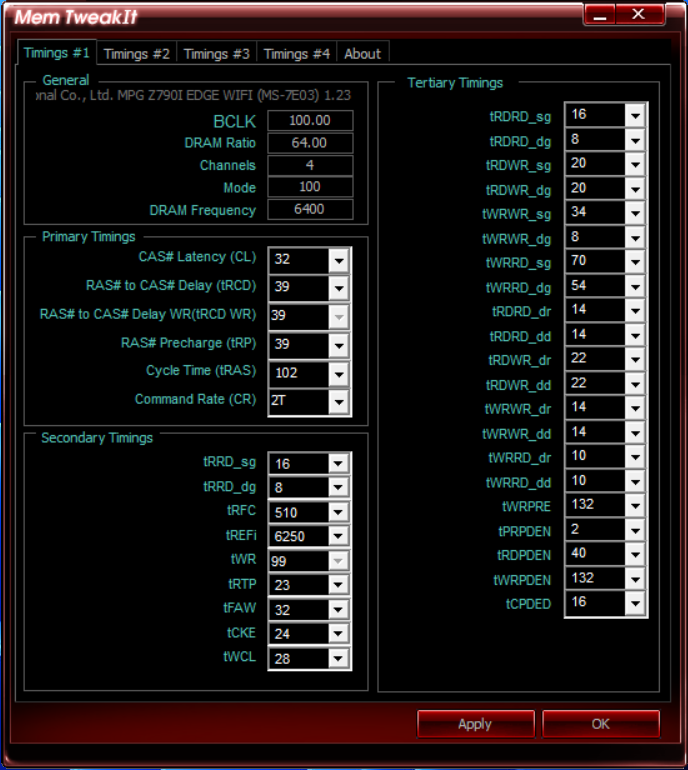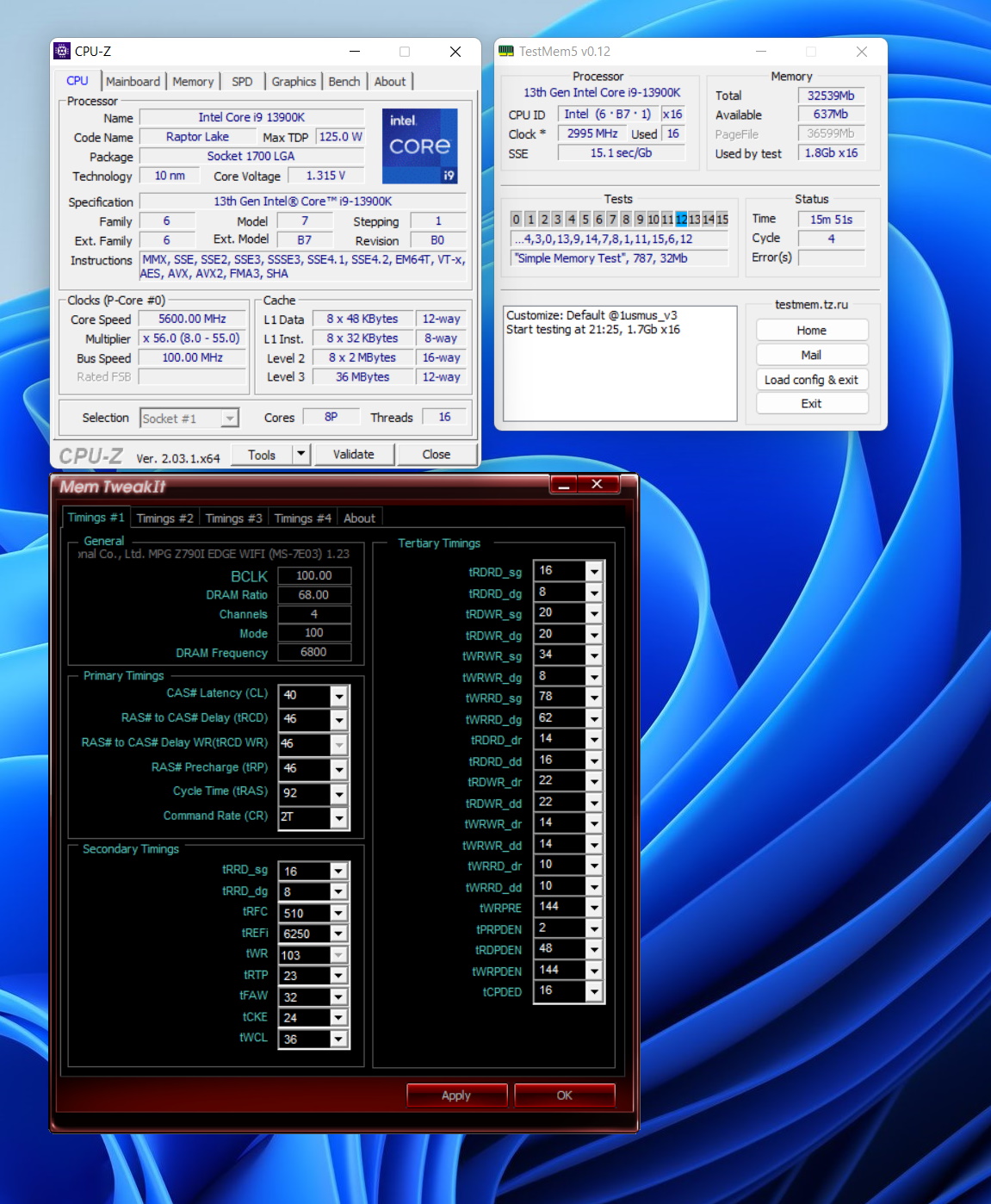Meanwhile, DDR5 memory has become much more affordable. This is a positive and important trend. Even though DDR4 is still very popular, DDR5 can significantly increase gaming performance in some cases. This is particularly the case if a workload is severely limited by memory bandwidth. For example, titles like Spider-Man Remastered respond strongly to the high bandwidth that DDR5 undoubtedly offers. Modern engines will increasingly behave very similarly in the future. In some cases high CPU performance is important in order to be able to sufficiently utilize faster graphics cards. Especially when ray tracing comes into play the CPU increasingly turns out to be a bottleneck when it comes to achieving good frame rates. Fast RAM can often help here and should therefore not be underestimated.

Specifications
| Manufacturer: | ADATA Technology (XPG Consumer Line) |
|---|---|
| Model: | AX5U6400C4016G-B |
| Transfer Rate: | DDR5-6400 MT/s (XMP) |
| Timings: | 40-40-40-76-116 (XMP) |
| Voltage: | 1.4V |
| DRAM Manufacturer: | SK Hynix |
| Form Factor: | 288-pin DIMM |
CPU-Z Screenshot (SPD Tab)

Packaging and Content
The packaging is designed from reddish glossy cardboard in contrast to the memory kit itself. The matte surface of the heatspreader is ribbed with a slightly slanted XPG lettering applied to a slightly reflective triangle on top. The overall appearance is simple and elegant. If the kit is installed in a closed case the "inner values" like performance, overclocking potential and temperature behavior are more important of course. We will take a closer look at exactly these things in this review. The focus is on the gaming performance of the memory.
Methodology
Frametimes were captured using CapFrameX in version v1.7.1 Beta.
Configuration of CX
- Overlay refresh rate 1000ms
- Auto-disable OSD enabled
- Run History and Aggregation enabled
- Outlier tolerance 3%
- 3 valid runs with a duration of 20 seconds = 1 valid session
- 5 runs with offline aggregation if required
- Sensor logging enabled with a refresh rate of 500ms
- Default configuration of sensor logging for standard benchmarks
Game settings
- Resolutions: 720p, 3840x1600 + DLSS/FSR with highest quality
- Raytracing enabled when available
- All other settings maximized to maximize draw calls
Overall, demanding custom scenes were used to maximize stress on CPUs and memory.
Metrics
- Average FPS
- 1% and 0.2% percentiles, not sensitive to reproducible and especially random outliers.
Test System
An open test bench was used for the entire tests. In order to cool the memory a 140mm fan was used, which was placed on the kit and operated constantly at around 700rpm. The motherboard was mounted horizontally on the benchtable. A Seasonic PRIME PX PX-1300 1300 watt power supply provided power to the components. The i9-13900K processor was cooled with an Arctic Liquid Freezer II 360 AiO. The graphics output was handled by an Nvidia GeForce RTX 4090 Founders Edition.
System
OS: MS Windows 11 Pro Build 22000 Version 21H2
Graphics driver: Nv Game Ready Driver 526.98
Z790 Test System
CPU: Intel i9-13900K, P-cores 5.6GHz, E-cores disabled, ring bus 4.9GHz
Graphics card: Nvidia GeForce RTX 4090 FE
Mainbard: MSI MPG Z790I Edge WIFI
The stability of the RAM OC was carried out with TestMem5. The condition for stability was 20 cycles without errors.

Configuration and Timings
The XPG Caster memory kit competed against an (almost) equivalent kit from G.Skill being part of the Trident Z5 RGB series. The transfer rate is 6400MT/s and the XMP main timings are CL32-39-39-102. Two configurations were tested, XMP profile on the one hand and the other a custom OC profile which also includes optimized subtimings.
 G.Skill Trident Z5 RGB DDR5-6400 XMP Timings
G.Skill Trident Z5 RGB DDR5-6400 XMP Timings
Memory Bandwidth and Latency
The most important properties of memory are bandwidth and access time/latency. The bandwidth was measured with AIDA64. Latency was measured with an open-source tool that allows multi-point measurement and covers a test depth of up to 1GB. This allows latency measurements that are largely independent of the CPU cache.
Write and Copy increased the most due to the RAM tuning. Read shows almost 5% improvement. Because the timings of the XMP profile are less tight compared to the G.Skill kit, the XPG kit had less bandwidth and thus less performance. The following gaming benchmarks helped to evaluate how strong the influence on the gaming performance really is.
 XPG Caster vs G.Skill Trident Z5 Memory Latencies
XPG Caster vs G.Skill Trident Z5 Memory Latencies
Based on the maximum test depth of 1GB the memory latency droped significantly from over 80ns to about 70ns due to overclocking. The G.Skill kit was slightly faster with XMP profile due to the tighter timings. The XPG Caster kit had a latency of 81.3ns, whereas the G.Skill kit had 78.1ns.
Gaming Benchmark Suite
The used game benchmark suite includes a total of 7 games. The majority of the games were selected in such a way that CPU and memory are heavily stressed. The achievable frame rates were partly significantly below what modern monitors can display. What might seem surprising is the use of ray tracing for CPU tests. However, considering that ray tracing puts additional load on the CPU due to the lack of culling and an increased number of draw calls due to objects outside the invisible screen space makes the decision understandable.
- A Plague Tale: Requiem
- Call of Duty: Modern Warfare 2
- Fary Cry 6 (Raytracing)
- Gotham Knights (Raytracing)
- Horizon Zero Dawn
- Kingdom Come: Deliverance
- Marvel's Spider-Man: Miles Morales (Raytracing)
Gaming Benchmarks 720p
A Plague Tale: Requiem
- API: DirectX 12
- Engine: Zouna Engine

Call of Duty: Modern Warfare 2
- API: DirectX 12
- Engine: IW 9.0

Fary Cry 6 (Raytracing)
- API: DirectX 12
- Engine: Dunia 2 Engine

Gotham Knights (Raytracing)
- API: DirectX 12
- Engine: Unreal Engine 4

Horizon Zero Dawn
- API: DirectX 12
- Engine: Decima Engine

Kingdom Come: Deliverance
- API: DirectX 11
- Engine: CryEngine

Marvel's Spider-Man: Miles Morales (Raytracing)
- API: DirectX 12
- Engine: Insomniac Games inhouse Engine

Gaming Benchmarks 3840x1600 + Upscaler
A Plague Tale: Requiem
- API: DirectX 12
- Engine: Zouna Engine

Call of Duty: Modern Warfare 2
- API: DirectX 12
- Engine: IW 9.0

Fary Cry 6 (Raytracing)
- API: DirectX 12
- Engine: Dunia 2 Engine

Gotham Knights (Raytracing)
- API: DirectX 12
- Engine: Unreal Engine 4

Horizon Zero Dawn
- API: DirectX 12
- Engine: Decima Engine

Kingdom Come: Deliverance
- API: DirectX 11
- Engine: CryEngine

Marvel's Spider-Man: Miles Morales (Raytracing)
- API: DirectX 12
- Engine: Insomniac Games inhouse Engine

Temperature Behavior
The temperature of the memory was logged with HWiNFO. The update interval was left at 2 seconds (default). The ambient temperature was measured with a conventional weather station with indoor sensor.

As shown in the graphic, the measurement had errors/outliers. This can be caused by invalid sensor readings or software bugs. The reason is eventually unclear. After about 15 minutes the temperature settled to a constant level. The XPG Caster Kit had slightly better temperatures, whereby the difference between module A and B was bigger than for the G.Skill Kit.

Overclocking the memory increases the thermal stress. Active cooling ensured an approx. 10°C lower temperature. At an ambient temperature of over 30°C critical temperatures of over 70°C can occur without active cooling of the memory. It is therefore recommended in summer, for example, to use the XMP profile as an alternative or to actively cool the memory with a fan.
Overclocking Potential
The overclocking potential was not fully exhausted with a transfer rate of 6600MT/s. 6800MT/s was also possible, whereby the timings were not optimized. Its only purpose was to check the limit of the RAM briefly. Generally, you need a suitable board if you want to go higher than 6200MT/s. The new Intel Z790 generation generally has a higher overclocking potential, but Z690 2-DIMM boards (e.g. ASUS Apex) are suitable as well. It is important to find out about the board's limitations beforehand, otherwise you can waste a lot of money. The MSI Z790 motherboard used for this test allows transfer rates beyond 8000MT/s.

Conclusion
What is the conclusion for the XPG Caster DDR5-6400 memory kit? An important and very positive point is that ADATA has deciced to use DRAM from Hynix. From experience, Hynix DRAM offers better overclocking potential than Samsung DRAM. The heatspreader design is sleek and overall good-looking. The temperature behavior with XMP and overclocking profile was good. Due to the fact that the timings of the XMP profile are not as tight as those of the G.Skill memory kit, optimization potential remains unused, although the performance difference in the gaming benchmarks is rather small. Overall, the gaming performance is already very good using the XMP profile.
Pro
- Hynix DRAM
- Good optimization potential (6800MT/s)
- Heatspreader with good cooling performance
- Heatspreader with appealing design
- High gaming performance with XMP profile
Contra
- XMP profile with loose timings
- Invalid temperature sensor readings (can also be software related)
